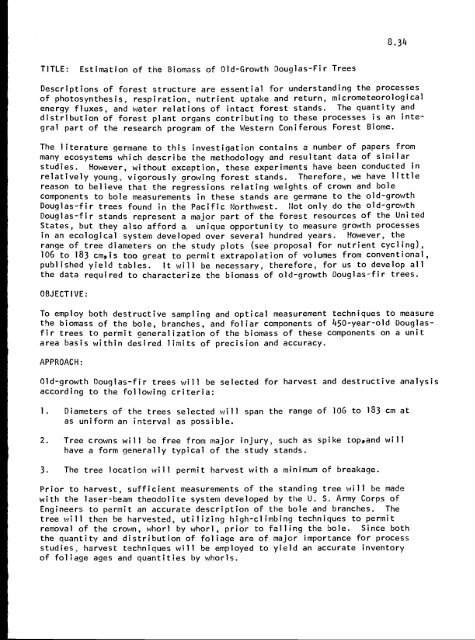FOREST BIOME - ScholarsArchive at Oregon State University
FOREST BIOME - ScholarsArchive at Oregon State University
FOREST BIOME - ScholarsArchive at Oregon State University
Create successful ePaper yourself
Turn your PDF publications into a flip-book with our unique Google optimized e-Paper software.
TITLE: Estim<strong>at</strong>ion of the Biomass of Old-Growth Douglas-Fir Trees<br />
8.34<br />
Descriptions of forest structure are essential for understanding the processes<br />
of photosynthesis, respir<strong>at</strong>ion, nutrient uptake and return, micrometeorological<br />
energy fluxes, and w<strong>at</strong>er rel<strong>at</strong>ions of intact forest stands. The quantity and<br />
distribution of forest plant organs contributing to these processes is an integral<br />
part of the research program of the Western Coniferous Forest Biome.<br />
The liter<strong>at</strong>ure germane to this investig<strong>at</strong>ion contains a number of papers from<br />
many ecosystems which describe the methodology and resultant d<strong>at</strong>a of similar<br />
studies. However, without exception, these experiments have been conducted in<br />
rel<strong>at</strong>ively young, vigorously growing forest stands.<br />
Therefore, we have little<br />
reason to believe th<strong>at</strong> the regressions rel<strong>at</strong>ing weights of crown and bole<br />
components to bole measurements in these stands are germane to the old-growth<br />
%<br />
D<br />
ouglas-fir trees found in the Pacific Northwest.<br />
Not only do the old-growth<br />
Douglas-fir stands represent a major part of the forest resources of the United<br />
St<strong>at</strong>es, but they also afford a. unique opportunity to measure growth processes<br />
in an ecological system developed over several hundred years. However, the<br />
range of tree diameters on the study plots (see proposal for nutrient cycling),<br />
106 to 183 cm,is too gre<strong>at</strong> to permit extrapol<strong>at</strong>ion of volumes from conventional,<br />
published yield tables. It will be necessary, therefore, for us to develop all<br />
the d<strong>at</strong>a required to characterize the biomass of old-growth Douglas-fir trees.<br />
OBJECTIVE:<br />
To employ both destructive sampling and optical measurement techniques to measure<br />
the biomass of the bole, branches, and foliar components of 450-year-old Douglasfir<br />
trees to permit generaliz<strong>at</strong>ion of the biomass of these components on a unit<br />
area basis within desired limits of precision and accuracy.<br />
APPROACH:<br />
Old-growth Douglas-fir trees will be selected for harvest and destructive analysis<br />
according to the following criteria:<br />
1. Diameters of the trees selected will span the range of 106 to 183 cm <strong>at</strong><br />
as uniform an interval as possible.<br />
2. Tree crowns will be free from major injury, such as spike top,and will<br />
have a form generally typical of the study stands.<br />
3. The tree loc<strong>at</strong>ion will permit harvest with a minimum of breakage.<br />
Prior to harvest, sufficient measurements of the standing tree will be made<br />
with the laser-beam theodolite system developed by the U. S. Army Corps of<br />
Engineers to permit an accur<strong>at</strong>e description of the bole and branches. The<br />
tree will then be harvested, utilizing high-climbing techniques to permit<br />
removal of the crown, whorl by whorl, prior to felling the bole. Since both<br />
the quantity and distribution of foliage are of major importance for process<br />
studies, harvest techniques will be employed to yield an accur<strong>at</strong>e inventory<br />
of foliage ages and quantities by whorls.
















